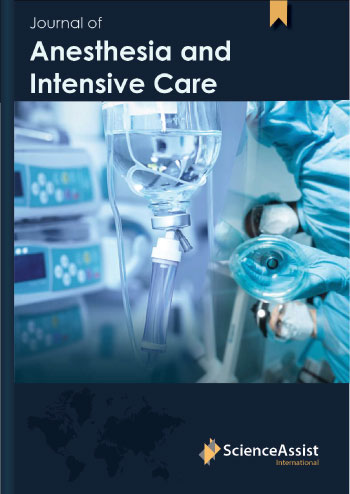
Volume 2, Issue 1 (2021)
ABBREVIATIONS
Mg-milligram; Kg-kilogram; Mmmillimeter; μg-microgram; MAC-minimum alveolar concentration; % - percentage; PRBC- packed red blood cell; PaCO2- carbon dioxide alveolar partial pressure; O2 Sat- oxygen saturation; ml- milliliter; MmHg- millimeter mercury; ICU- intensive care unit; Bpm- breathe per minute.
BACKGROUND
Macroglossia is an uncommon and lethal postoperative complication following neurosurgical procedures mainly in the posterior fossa surgery [1-10]. The estimated incidence of this complication is around 1% 9. However, the complication is still underreported. The etiology of macroglossia is still unclear, and has been attributed to compression (arterial, venous, or mechanical), and to neurogenic origin [6,9].
CASE PRESENTATION
A 37-year-old single female patient, known case of suprasellar brain tumor (low-grade glioma with pilocytic features), she is not known to have any allergies. She underwent left parietal craniotomy & partial excision of the tumor in 2000 followed by chemotherapy and radiotherapy. In 2014 she started to complain of blurred vision, her condition was diagnosed as metastatic sub-thalamic brain tumor and planned for craniotomy, biopsy and debulking of the tumor using the navigation system. The procedure lasted for 10 hours and in semi-sitting position with her neck flexed and a throat pack was inserted. The patient was invasively monitored intraoperatively with left radial arterial line and right internal jugular central line. Induction of anesthesia carried with propofol (2 mg/ kg) and fentanyl (1.5μg/kg) and maintained inhalational isoflurane (1 MAC); along with muscle relaxation injecting cisatracurium (0.15 mg/kg) intubation with an endotracheal tube (internal diameter 7.5mm) and the patient was attached to continuous infusion. She was given intra-operatively 3 liters of crystalloids and one unit of PRBC transfused with adequate urine output. Consequently, her vital signs were stable all through the procedure, mean blood pressure around 65 mmHg, PaCO2 33 mmHg and oxygen saturation 99%.
DISCUSSION
Macroglossia is an uncommon and lethal postoperative complication following neurosurgical procedures mainly in the posterior fossa surgery [1-10]. The estimated incidence of this complication is around 1% 9. However, the complication is still underreported. The etiology of macroglossia is still unclear, and has been attributed to compression (arterial, venous, or mechanical), and to neurogenic cause [6,9]. The etiology of macroglossia is suggested to be multifactorial. These factors can be classified as: mechanical compression (by teeth, oropharyngeal airway, endotracheal tube, throat pack) obstructing the venous or lymphatic drainage of the tongue; another factor is positional obstruction (due to excessive neck flexion, head position); or combinations of these two factors. Our review of similar neurosurgical cases reported in literature as in Table 1. 36 cases of macroglossia were reported, many were in posterior fossa intracranial procedures.
Our explanation may attribute to the surgical approach as positioning may lead to venous obstruction. Away from positioning, posterior fossa surgical access requires flexion and rotation of the neck altering the venous circulation, this could not be externally inspected. Although, many reported cases in literature were in sitting position, 1 also other case were in other positions (Table 1). Our analysis of macroglossia onset in 36 reviewed cases (Table 1), suggest: severe form where venous obstruction (with or without local compression), tends to be more rapid and dangerous. The milder form, there is local lymphatic congestion (caused either by local compression or by venous obstruction) leads to swollen tongue. Airway obstruction is unlikely to happen because the swelling can be immediately recognized, and extubating of the trachea can be delayed.
CONCLUSION
In summary, review of the literature and as in our case, we suggest that macroglossia risk factors include neck flexion (position), obesity, local compression, and long surgical duration. The risk of complete airway obstruction is always present, and anesthesiologists need to be aware of this potential life-threatening complication because the onset of macroglossia may be delayed
1. Kuhnert SM, Faust RJ, Berge KH, and Peipgras DG. Postoperative macroglossia: Report of a case with rapid resolution after extubation of the trachea. Anesth Analg. 1999;88(1):220-223
2. Narayan VB, Rao GSU. Unilateral facial and neck swelling after infratentorial surgery in the lateral position. Anesth Analg. 1999;89(5):1290-1291.
3. Szu-Kai Hsu, Cheng-Ta Hsieh, Chih-Ta Huang, JingShan Huang. Delayed airway obstruction in posterior fossa craniotomy with park-bench position. Surg Sci. 2012;3(11):526-529
4. Mei-Ching Huang, Yung-Cheng Wang, Jing-Shan Huang, Kou-Mou Huang. A rare presentation of hemi facial swelling following neurosurgery in lateral position: A Case Report. Clin Mol Med. 2012;3(1):7-9
5. S. Toyama, K. Hoya, K. Matsuoka, T. Numai and M. Shimoyama. Massive macroglossia developing fast and immediately after endotracheal extubation. Acta Anaesthesiol Scand. 2012;56(2):256-259.
6. Yassine El H, Narata AP, Pereira VM, Schaller C. A reminder for a very rare entity: massive tongue swelling after posterior fossa surgery. J Neurol Surg A Cent Eur Neurosurg. 2012;73(3):171-174
7. Chowdhury T, Gupta N, Rath GP. Macroglossia in a child undergoing posterior fossa surgery in sitting position. Saudi J Anaesth. 2012;6(1):85-86.
8. Junghaenel S, Keller T, Mischkowski R, Hinkelbein J, Beutner D, Koerber F, et al. Massive macroglossia after palatoplasty. Eur J Pediatr. March 2012;171(3):433-437
9. Maher JL, Mahabir RC, Read LA. Acute macroglossia in the pediatric patient: worth a look. Pediatr Emerg Care. 2011;27(10):948-949. 10. Sharma PK, Bhakta P, Srinivasan S, Khan RM, Kaul N. Acute tongue enlargement secondary to pharyngeal packing after tracheal intubation-A case report. Middle East J Anaesthesiol. 2012;21(5):761-764
